For beef labelled London Broil, Top Round, or Flank Steak, this classic London Broil technique gets you a tender, juicy, and flavorful roast.
Have you seen meat at the store labeled as “London Broil” and been confused as to what that means? I’m breaking down what that term means and how to make a version that is full of flavor.
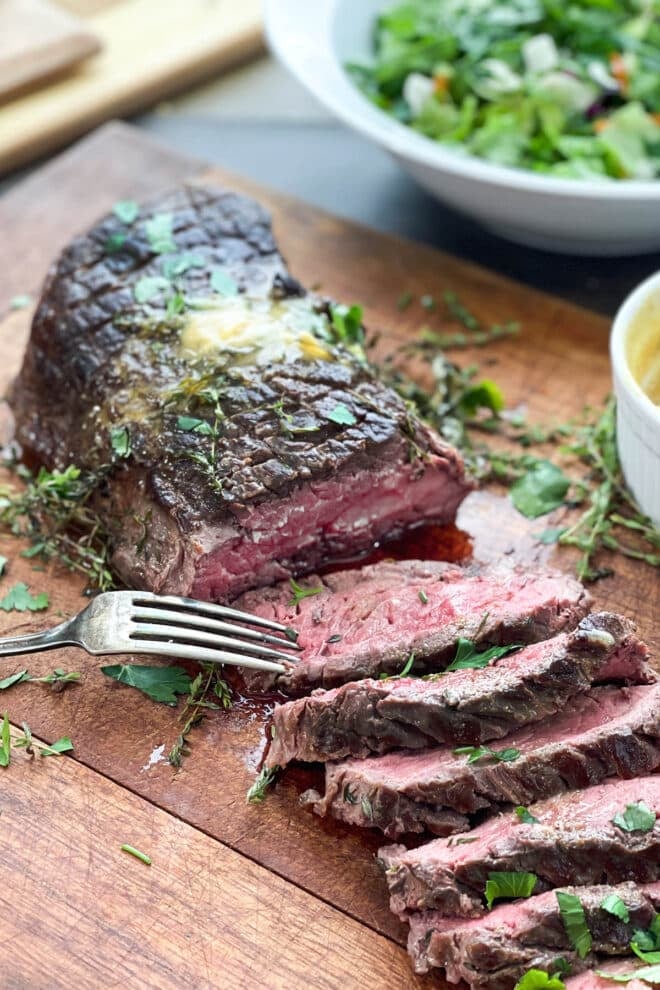
What Is London Broil?
Despite its name, the London Broil is not from England – it is a North American dish. London broil was originally a cooking technique used on less expensive and leaner cuts of meat. The idea was to give extra flavor to these cuts and to keep them juicy by not over-cooking them. The technique involved quickly pan-searing or broiling the meat and then slicing it against the grain, diagonally. These days, there’s often a salty or vinegar-based marinade involved as well.
Cut Of Meat
Even though the term London Broil refers to the technique and not the cut of meat, these days you’ll often find cuts of meat that are labeled London Broil. So, what are those? In general, if the store has labeled the meat as a London Broil, you can cook it using the London Broil method. Usually the cuts that are labelled in this way are those exact less-expensive, lean cuts that are well-suited to the technique.
Sometimes the label is applied to flank steak. However, since flank has become more popular and people are more familiar with the name, it tends to now usually be labelled as flank. In recent years, it is usually top round steak that gets the label. So, if you have purchased something that says it’s London Broil, that’s probably what you have, and so that is what I have used in this recipe. If you, have something labelled Flank Steak, you can use that as well.
Do I Need To Marinate?
Most recipes still use a liquid marinade, relying on soy sauce to season and tenderize the meat. However, I find that using strong marinades with soy sauce, balsamic vinegar, and Worcestershire sauce end up masking the beefy flavor of the top round roast. You can read about why I think you shouldn’t have soy sauce as the main ingredient in your marinades on my other website, TheCookful.
Because of that, I’m instead using a dry rub and then dry-aging (and essentially dry-brining) the steak in the refrigerator. If you’ve made my Classic Roast Beef recipe, then you know how much that dry-brining step improves the meat’s flavor and texture.
To get a little bit of that marinade flavor that many people are used to from London Broil without actually doing a marinade, I decided to make a finishing butter that contains soy sauce. In this way, you get some of that meaty, umami, salty flavor at the end, but it isn’t soaking right in and affecting all of the steak’s flavor and texture. Still, if you prefer to do the more traditional liquid marinade for your London Broil? Take a look at my best steak marinade recipe over here.
How To Dry-Age Beef
You can easily dry-age and essentially dry-brine any cut of beef by salting it and leaving it uncovered in the refrigerator up to three days. The longer it stays in the fridge, the more seasoned it will be.
Scoring the meat with a diagonal pattern provides more surface area for the dry rub to penetrate, adding more flavor. This is an important step especially if you want to skip the dry-aging process and cook the roast the same day.
To create the hashmarks, use a sharp knife to cut shallow diagonal slices across the roast, about ⅛-inch deep. Repeat in the opposite direction to create hash marks, and then repeat this process on the other side of the roast.
Then, mix together the dry rub ingredients – the salt, pepper, onion powder, and garlic powder. Divide this mixture in half and rub half into the top of the roast, and flip it over to put the rest on the other side.
Transfer the roast onto a wire rack that has been fitted into a sheet pan. Refrigerate this for at least 30 minutes, and as long as three days. The longer it rests in the refrigerator, the deeper the seasonings can penetrate. It also makes the outside of the meat drier, which will yield a darker, crisper crust.
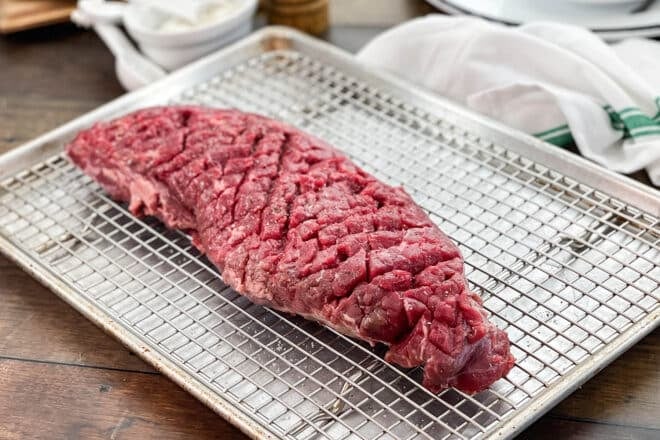
Making The Finishing Butter
This finishing butter goes on the steak at the end after it’s cooked. So, you’ll make it while the meat is in the fridge dry-aging. It has so much flavor even though it’s very simple. My favorite thing about it is that it mimics the flavor of a typical beef marinade but with a softer, less harsh, effect.
To make the soy sauce butter, mix together a stick of salted, room temperature butter (that’s 8 tablespoons) with one teaspoon of soy sauce. Simple, right? But so so so good!
Cooking The London Broil
Remove the roast from the refrigerator and preheat the oven to 420F. Heat the olive oil in a large oven-proof skillet until shimmering, then add the roast to the pan. Sear the roast on one side, then flip and sear on the other side. When searing the second side, you can add hearty herbs like fresh thyme or rosemary if you’d like for additional flavor.
Place the pan into the oven and bake until the roast reaches the desired internal temperature. You can test the temperature with an instant-read thermometer or using a thermometer probe that is left in the meat while it roasts. It will be about 10-12 minutes for medium-rare, and about 14-15 minutes for medium.
Medium-rare and medium are both good choices for this cut. Any more well done than medium will be a bit tougher. If you’re going to cook it to that temperature, be sure to slice your meat thinly later on.
- Rare: 125°F or 52°C (Remove from the oven at 120°F or 49°C.)
- Medium-rare: 135°F or 57°C (Remove from the oven at 130°F or 54°C.)
- Medium: 145°F or 63°C (Remove from the oven at 140°F or 60°C.)
- Medium-well: 150°F or 66°C (Remove from the oven at 145°F or 63°C.)
- Well done: 160°F or 71°C (Remove from the oven at 155°F or 68°C.)
Remove the pan from the oven and let the roast rest for about 10 minutes in the pan. Transfer the roast to a cutting board, drizzle with pan drippings, and add a few dollops of the soy sauce butter and fresh parsley on top of the roast before slicing. Serve the remaining butter and pan drippings on the side.
Top round is a lean cut of beef and can be tough, even when properly cooked. Slicing the roast thin and against the grain will ensure that it remains just as tender as it is flavorful.
Podcast Episode: Cooking London Broil
Listen to learn how to make this recipe, along with some great tips from Christine, by clicking the play button below:
Listen to more Recipe of the Day episodes here.
Print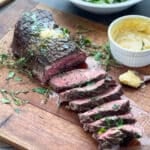
London Broil Recipe
- Prep Time: 15 minutes
- Rest Time: 40 minutes
- Cook Time: 15 minutes
- Total Time: 1 hour 10 minutes
- Yield: 6 servings 1x
- Category: Entrée
- Method: Baked
- Cuisine: American
DESCRIPTION
The London Broil technique is a wonderful way to cook larger inexpensive, lean cuts of beef. This recipe doesn’t use a marinade but instead has a dry-aging step. To get the marinade-style flavor that is often associated with this dish, you’ll instead make a soy sauce butter to dollop onto the meat after it’s cooked. Don’t skip the butter! It adds so much flavor and is really luscious!
Ingredients
- 1 (3 lb.) top round roast
- 1 Tbsp. salt
- 1/2 tsp. ground black pepper
- 2 tsp. granulated garlic
- 2 tsp. onion powder
- 8 Tbsp. salted butter (1 stick), room temperature
- 1 tsp. soy sauce
- 3 Tbsp. olive oil
Instructions
- Using a sharp knife, on both the top and bottom, make shallow diagonal slices across the roast, about ⅛-inch deep. Repeat in the opposite direction to create hash marks.
- In a small bowl combine salt, pepper, garlic powder, and onion powder. Divide mixture evenly between top and bottom, and rub into hash marks.
- Transfer roast to a wire rack fitted into a sheet pan. Refrigerate roast at least 30 minutes or up to three days, uncovered.
- Meanwhile, in a small bowl combine butter and soy sauce. Refrigerate until ready to use.
- Remove roast from refrigerator. Let stand while oven preheats.
- Preheat oven to 420°F.
- In a large, oven-proof skillet heat olive oil over medium-high heat until shimmering. Place roast into pan. Sear on one side, about 3 minutes.
- Flip roast over and place pan in oven.
- Roast 10-12 minutes or until an instant-read thermometer inserted into the thickest part of the roast registers 130°F for medium-rare, or until desired temperature is reached based on the chart below.
- Remove pan from oven, let stand 10 minutes. Transfer roast to cutting board. Top roast with pan drippings and the soy sauce butter. Slice thinly against the grain and serve.
Love this recipe? I’d appreciate it if you could scroll down and add a *5 star rating* to help others know they’ll love it as well!
Notes
- Rare: 125°F or 52°C (Remove from the oven at 120°F or 49°C.)
- Medium-rare: 135°F or 57°C (Remove from the oven at 130°F or 54°C.)
- Medium: 145°F or 63°C (Remove from the oven at 140°F or 60°C.)
- Medium-well: 150°F or 66°C (Remove from the oven at 145°F or 63°C.)
- Well done: 160°F or 71°C (Remove from the oven at 155°F or 68°C.)
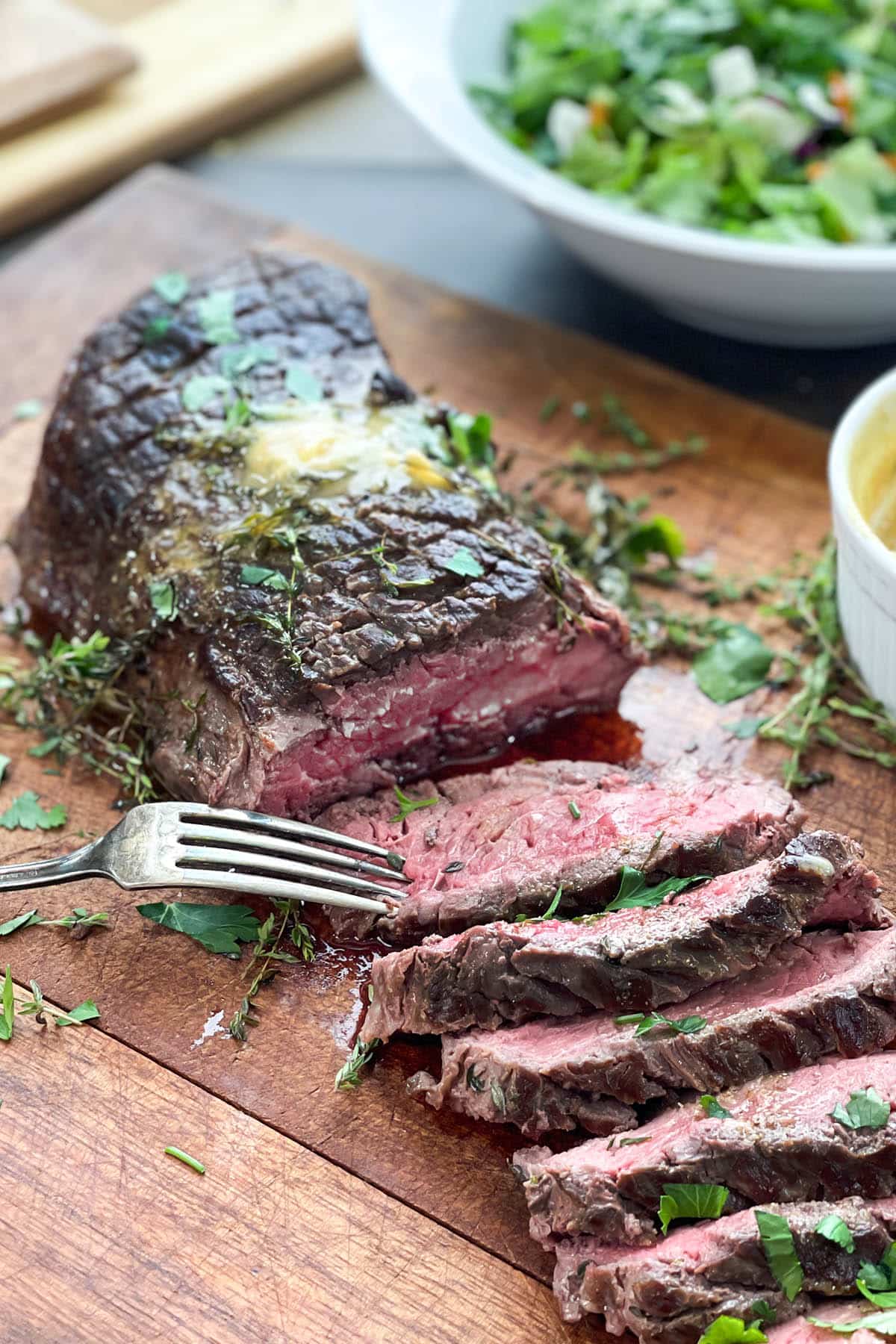

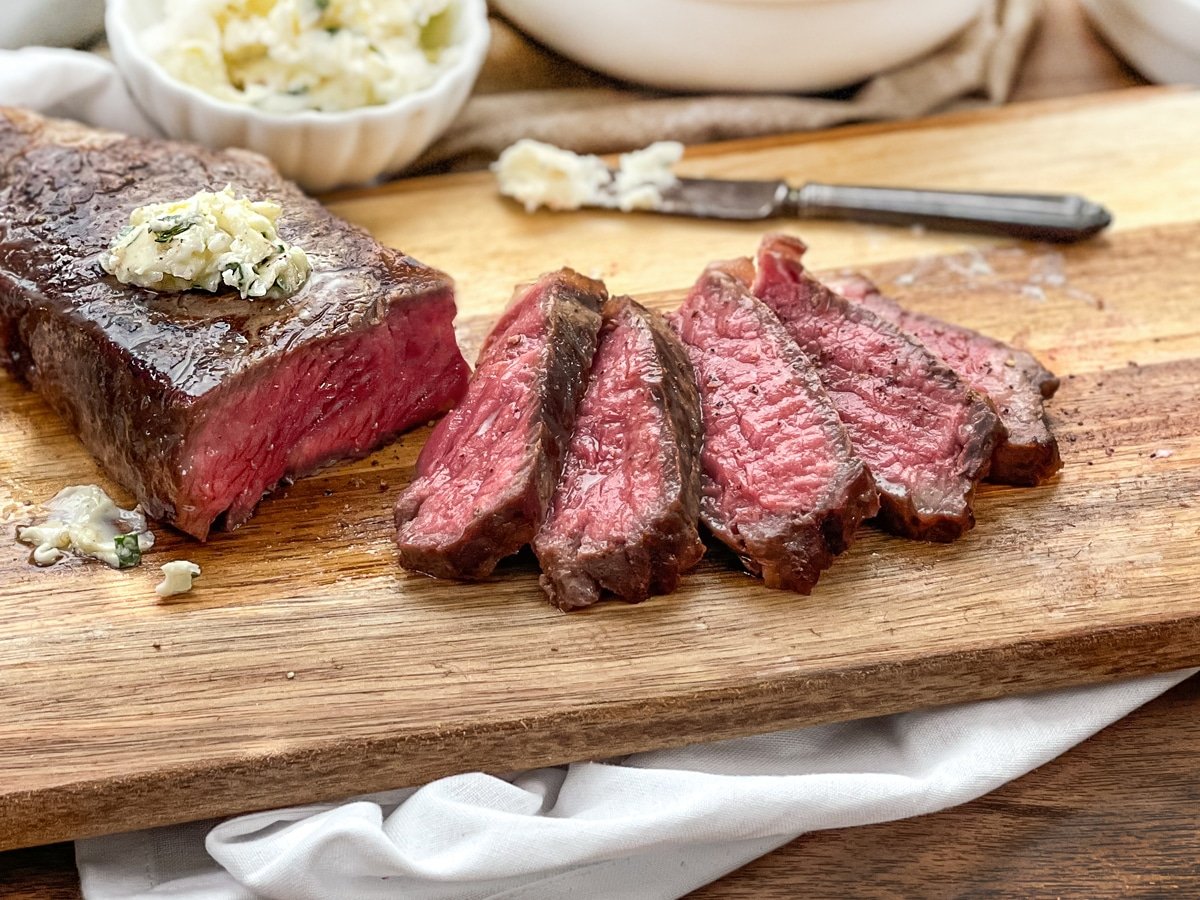
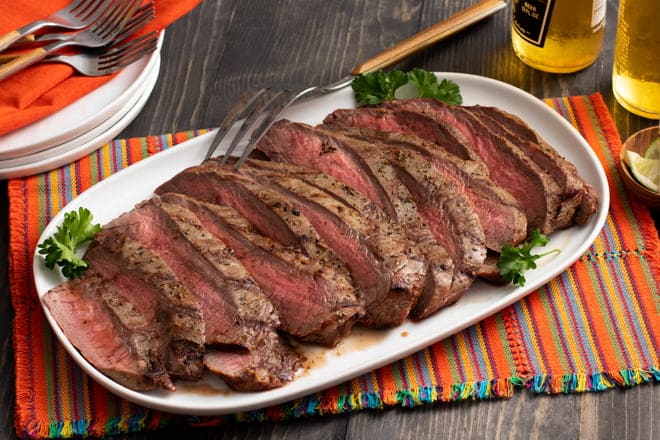
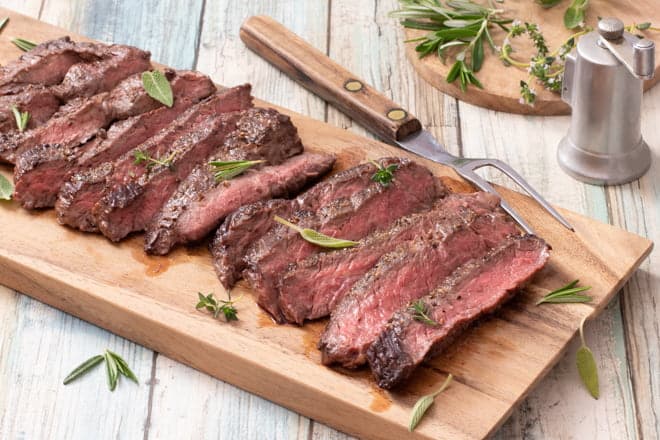
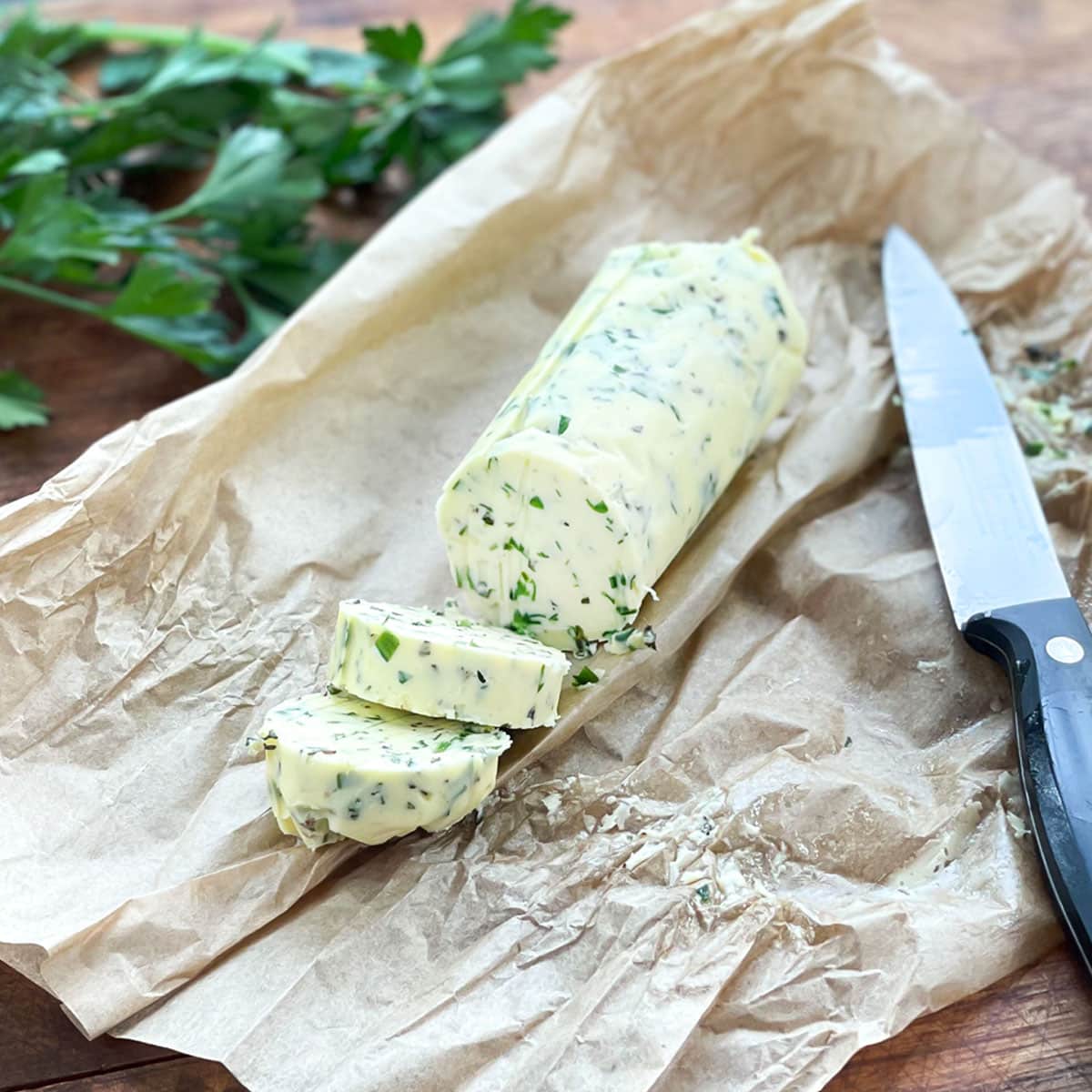



















This resulted in a remarkable roast. I sauteed in peanut oil which really boosted the flavor. I am going to use the same recipe on a pork roast next.
Valerie, I’m so happy you liked it! Peanut oil is such a great fat to use. I’m glad that worked for you!
Unbelievable! Absolutely delicious 😋
Thank you so much, Teresa! I’m glad you enjoyed.
Wow, now I know! Wonderful and simple.
Glad it helped, L!
Easy and delish!
Thank you so much, Renee! So thrilled you loved it.
Omg so good! I don’t think I will ever use any other process again! I let my London Broil sit for 2 days using your rub – it was perfectly pink in the center and oh so flavorful and tender. The butter added just the right touch. I sautéed mushrooms separately (using the butter mixture) and had it on the side. That, along with Bacon, walnut & honey brussel sprouts and my family had one delicious meal! Thank you for sharing this technique!
Wow, that sounds like an impressive meal, Renee! Thank you so much for coming back to share that with me.
This recipe was delish! I had always wondered what London Broil was so this was a very helpful explainer. Very easy preparation, and great flavor. And this cut of beef is great value. Thanks for all the great info!
You’re welcome, Rachel! I’m glad the information was helpful for you. :)